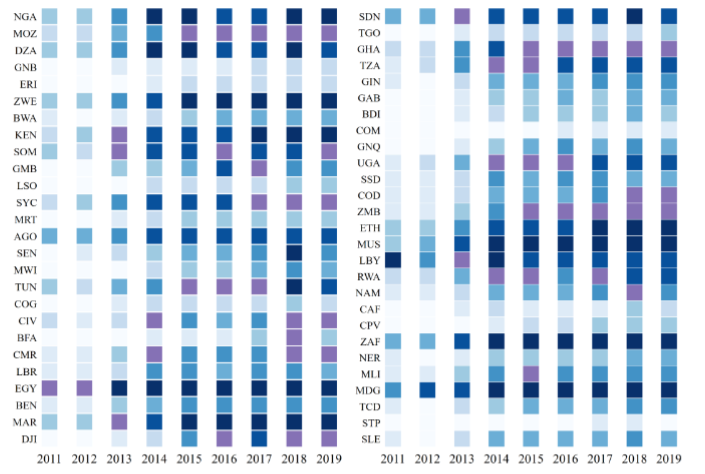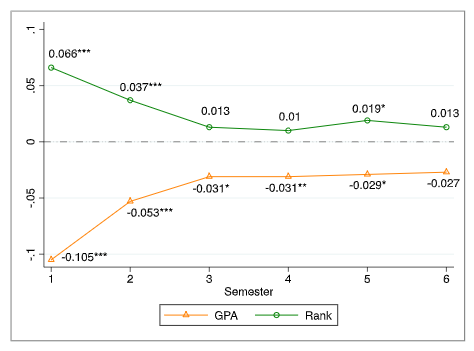Consumers’ attitude towards meat brands: Evidence from pork products in Guangzhou, China
Abstract
This study aims to investigate the factors influencing consumers’ cognitive attitude towards the brands of products during their consumption willingness, behaviors and choices. Taking pork brands as an example, this study conducts a questionnaire by using a random sampling method in 165 farmers’ meat markets and 54 supermarkets in Tianhe District, Yuexiu District, Liwan District, the representative districts in Guangzhou city in China, and obtains 1,050 valid observations of the pork consumers. The empirical results via a logit regression show that the factors significantly enhance consumers’ brand cognitive attitude include younger age; lower perception of product safety; less cognition of green food, frailer awareness of fresh, cold, and frozen meats, as well as weaker ability to identify a specific product. Also, stronger consumers’ brand attitude results from larger amount of money spent in a single purchase, stronger cognition of nuisance-free food, and higher identification of different types of pork meats.
Cite This Paper
Yan, F. (., Ouyang, X., & Qi, W. (2023). Consumers’ attitude towards meat brands: Evidence from pork products in Guangzhou, China. Review of Economic Assessment, 2(3), 16. doi:10.58567/rea02030001
Yan, F. (.; Ouyang, X.; Qi, W. Consumers’ attitude towards meat brands: Evidence from pork products in Guangzhou, China. Review of Economic Assessment, 2023, 2, 16. doi:10.58567/rea02030001
Yan F (, Ouyang X, Qi W. Consumers’ attitude towards meat brands: Evidence from pork products in Guangzhou, China. Review of Economic Assessment; 2023, 2(3):16. doi:10.58567/rea02030001
Yan, Fafa (.; Ouyang, Xi; Qi, Wen’e 2023. "Consumers’ attitude towards meat brands: Evidence from pork products in Guangzhou, China" Review of Economic Assessment 2, no.3:16. doi:10.58567/rea02030001
Funding
Share and Cite
Article Metrics
References
- Bi, S., Shao, L., Tu, C., Lai, W., Cao, Y., & Hu, J. (2023). Achieving carbon neutrality: the effect of China pilot Free Trade Zone policy on green technology innovation. Environmental Science and Pollution Research 30(17), 50234-50247. https://doi.org/10.1007/s11356-023-25803-1
- Cheng, P., and Z. Yin (2012), Risk Perception, Risk preference, and response of consumers to food safety crisis: The case of the clenbuterol pork, Management Review 24(12), 128-136. https://doi.org/10.14120/j.cnki.cn11-5057/f.2012.12.011
- Datta, P.R. (2003). The determinants of brand loyalty. Journal of American Academy of Business 3, 138-145
- De Jonge, J., Frewer, L., Van Trijp, H., Jan Renes, R., De Wit, W., and Timmers, J. (2004). Monitoring consumer confidence in food safety: An exploratory study. British Food Journal 106, 837-849. https://doi.org/10.1108/00070700410561423
- Feldmann, C., and Hamm, U. (2015). Consumers’ perceptions and preferences for local food: A review. Food Quality and Preference, 40, 152-164. https://doi.org/10.1016/j.foodqual.2014.09.014
- Hong, E., Park, J., Jaroenwanit, P., Siriyota, K., and Sothonvit, A. (2023). The effect of customer ethnocentrism and customer participation on global brand attitude: The perspective of Chinese customer. Journal of Retailing and Consumer Services 70, 103167. https://doi.org/10.1016/j.jretconser.2022.103167
- Hu, J. (2023). Synergistic effect of pollution reduction and carbon emission mitigation in the digital economy. Journal of Environmental Management 337, 117755. https://doi.org/10.1016/j.jenvman.2023.117755
- Hu, J., & Zhang, H. (2023). Has green finance optimized the industrial structure in China? Environmental Science and Pollution Research 30(12), 32926-32941. https://doi.org/10.1007/s11356-022-24514-3
- Hu, J., Hu, M., & Zhang, H. (2023). Has the construction of ecological civilization promoted green technology innovation? Environmental Technology & Innovation 29, 102960. https://doi.org/10.1016/j.eti.2022.102960
- Hu, J., Zhang, H., & Irfan, M. (2023). How does digital infrastructure construction affect low-carbon development? A multidimensional interpretation of evidence from China. Journal of Cleaner Production 396, 136467. https://doi.org/10.1016/j.jclepro.2023.136467
- Kapferer, J.N., and G. Laurent (1985). Consumer involvement profiles: A new and practical approach to consumer involvement. Journal of Advertising Research 25, 48-56. https://go.exlibris.link/lWNGZnxw
- Kotler, P. (1997). Marketing management: Analysis, planning, implementation and control. Prentice-Hall.
- Liang, Y., Cheng, Y., Xu, Y., Hua, G., Zheng, Z., Li, H., and Han, L. (2022). Consumer preferences for animal welfare in China: Optimization of pork production-marketing chains. Animals 12(21), 3051. https://doi.org/10.3390/ani12213051
- Liu, C., Han, Y., and Yu, Y. (2012). Analysis of pork consuming market in Beijing. Chinese Journal of Animal Science 48(8), 10-13, 19. https://kns.cnki.net/kcms2/article/abstract?v=3uoqIhG8C44YLTlOAiTRKgchrJ08w1e7fm4X_1ttJAn3uOX3nu9aspBxZGgu8qMfVnXO7_LZXwJlWyLc7mIw5Xu5FZEYwiTg&uniplatform=NZKPT
- McCarthy, T.M., and Golicic, S.L. (2010). Implementing collaborative forecasting to improve supply chain performance. International Journal of Physical Distribution & Logistics Management 32, 431-454. https://doi.org/10.1108/09600030210437960
- Rahnama, A., Alaei, A., Shafaee, J., and Ariana, A. (2012). Evaluation of relationship marketing dimension effect on degree of customer’s loyalty of insurance industry in Iran. Journal of Basic and Applied Scientific Research 2, 1842-1848. https://www.textroad.com/pdf/JBASR/J.%20Basic.%20Appl.%20Sci.%20Res.%2C%202(2)1842-1848%2C%202012.pdf
- Rahnama, A., Alaei, A., Shafaee, J., and Hamdam, H. (2012). Evaluating the impact of banking services quality on customer loyalty in mellat bank ardebil province. Journal of Basic and Applied Scientific Research 2, 2498-2506
- Rieger, J., Kuhlgatz, C., and Anders, S. (2016). Food scandals, media attention and habit persistence among desensitised meat consumers. Food Policy 64, 82-92. https://doi.org/10.1016/j.foodpol.2016.09.005
- Rozin, P., Pelchat, M.L., and Fallon, A.E. (1986). Psychological factors influencing food choice. In C. Ritson, L. Gofton, and J. McKenzie (Eds.), The food consumer. Chichester and New York: John Wiley & Sons Ltd, 85-106
- Wang, J., J. Ge, and Y. Ma, 2018, Urban Chinese consumers’ willingness to pay for pork with certified labels: A discrete choice experiment. Sustainability 10, 603. https://doi.org/10.3390/su10030603
- Wongsprawmas, R., Canavari, M., and Waisarayutt, C. (2015). Food safety assurance system for fresh produce production in Thailand: A review. Quality Assurance & Safety of Crops & Foods 7, 73-88. https://doi.org/10.3920/QAS2013.0255
- Wu, L., H. Wang, D. Zhu, W. Hu, and S. Wang, 2016, Chinese consumers’ willingness to pay for pork traceability information—the case of Wuxi. Agricultural Economics 47, 71-79. https://doi.org/10.1111/agec.12210
- Wu, L., S. Wang, D. Zhu, W. Hu, and H. Wang, 2015, Chinese consumers’ preferences and willingness to pay for traceable food quality and safety attributes: The case of pork. China Economic Review 35, 121-136. https://doi.org/10.1016/j.chieco.2015.07.001
- Yeomans-Maldonado, G., and Patrick, M.E. (2015). The effect of perceived risk on the combined used of alcohol and marijuana: Results from daily surveys. Addictive Behaviors Reports 2, 33-36. https://doi.org/10.1016/j.abrep.2015.05.004
- Yeung, R.M.W and Morris, J. (2001). Food safety risk: Consumer perception and purchase behaviour. British Food Journal 103 (3), 170-186. https://doi.org/10.1108/00070700110386728
- Yu, X., Gao, Z., and Zeng, Y. (2014). Willingness to pay for the “Green Food” in China. Food Policy 45, 80-87. https://doi.org/10.1016/j.foodpol.2014.01.003
- Zepeda, L. and Deal, D. (2009). Organic and local food consumer behaviour: Alphabet theory. International Journal of Consumer Studies 33, 697-705. https://doi.org/10.1111/j.1470-6431.2009.00814.x


